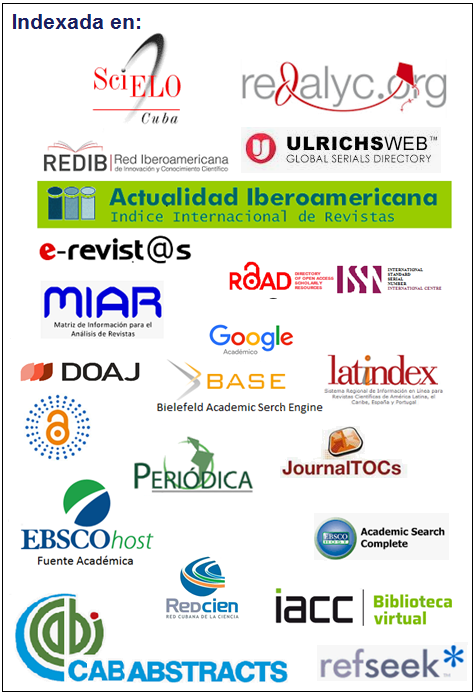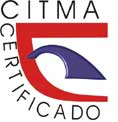Appraisal of rice husk usage as a heat insulating material in casting steel parts
Keywords:
heat insulating sleeve, cover powder, rice husk, cast steel, clean productions.Abstract
The present work aims to expose the positive effect of using rice husk, generated during the rice husk processing without previous preparation processes, as an auxiliary heat-insulating material in casting steel parts at the company Planta Mecánica from Santa Clara city. Its use is justified by good performance and easy handling during the steel parts production process and by being innocuous for workers’ health and the environment. The results show that using rice husk cap-powder combinations in foundry increases metal efficiency to 83% on average, increasing energy efficiency and decreasing raw material consumption. It has a positive environmental impact by taking advantage of an agro-industrial waste, reducing pollution and contributing to the saving of non-renewable natural resources.Downloads
References
Al-Shafe, A. y Azadur-Rahman, A. H. M. 2015: Development of Small Scale Low Cost Insulating Riser Sleeves from Scraps and by Products of an Existing Foundry Industry. International Journal of Innovative Science and Modern Engineering (IJISME), 3(11). ISSN: 2319-6386.
Aufderheide, R. C.; Showman, R. E.; Close, J. y Zins, E. J. 2002: Eliminating fish-eye defects in ductile castings. In: Transactions of the American Foundry Society and the One Hundred Sixth Annual Casting Congress (p. 917-927).
Breton, L. 1965: Defectos de las piezas de fundición. Tomo I. Bilbao, España: Ediciones URMO. 279 p.
Chauhan, P. D.; Anuvadiya, M. y Chauhan, V. 2017: Feeding and Gating System Design and Simulation of Flange Roller of Hydrators for Yield Melioration. Kalpa Publications in Engineering, 1: 548-556.
Cheng-Yang, D.; Jin-wu, K.; Hao-long, S.; Huang, T.; Xiao-peng, Z.; Yong-yi, H. y Tian-you, H. 2018: Insulation effect of air cavity in sand mold using 3D printing technology. China Foundry, 15(1): 37-43.
Cruz-Pérez, J. C. 2009: Empleo de la cáscara de arroz como material auxiliar en la fundición de piezas de acero al carbono. Jesús Eduardo González Ruiz y Lorenzo Perdomo González (Tutores). Tesis de maestría. Universidad Central de Las Villas. Santa Clara. 90 p.
Cruz-Pérez, J. C. 2012: Empleo de la Cáscara de Arroz en la Fundición de Piezas de Acero al Carbono. Revista Ingeniería Mecánica 15(2).
De las Pozas del Río, J. A. 2012: Contribución al empleo en Cuba de la ceniza de cascara de arroz. M. Sc. Ig. Neson Díaz Brito (Tutor). Tesis de maestría. Intituto Superior Politecnico José Antonio Echeverría. La Habana. 221 p.
Díaz-Pita, I. A. 2011: Elaboración de Elementos Constructivos a Partir de la Cáscara de Arroz. Facultad Agroforestal. Universidad de Pinar del Río Hermanos Saíz Montes de Oca.
Fernández, I. J.; Calheiro, D.; Sánchez, F. A. L.; Diehl-Camacho, A. L.; Avila de Campos-Rocha, T. L.; Medes-Moraes, C. A.; Caldas de Sousa, V. 2017: Characterization of Silica Produced from Rice Husk Ash: Comparison of Purification and Processing Methods. Materials Research, 20: 512-518.
FOSECO. 2003: How to calculate feeders. December.
Gerstman, S. L. y Bruhr, R. K. 1955: Empleo de la cáscara de arroz y de avena como material aislante en la mazarota. Revista Foundry, febrero. Ottawa, Canadá.
Idamayanti, D.; Purwadi, W.; Bandanadjaja, B. y Triadji, R. 2020: Rice Husk Waste as an Exothermic Material for a Riser Sleeve for Steel Casting. International Journal of Technology, 11(1): 71-80. Consulta: 22/06/2020. Disponible en: http//ijtech.eng.ui.ac.id.
Kyu-Jin, C.; Yoon-Seo, H.; y Gil-Kang, C. 2017: Heating System for Riser Size Minimizing in Sand Casting Process and Its Experimental Verification. Metals, 7(4): 130.
Miller, W. C. 1977: Insulating refractory fiber composition and articles for use in casting ferrous metals. United States Patents.
Ochulur, E. F.; Amuda, H. O. H.; Adeosun, S. O. y Balogun, S. A. 2017: Effect of aluminum dross and rice husk ash on thermal and moulding properties of silica sand. Nigerian Journal of Technology, 36(3): 794–800. Electronic ISSN: 2467-8821. Consulta: 22/06/2020. Disponible en: www.nijotech.com. http://dx.doi.org/10.4314/njt.v36i3.19.
Olivier, P. A. 2011: Ph. D. Engineering, S. R. L. The rice hull house.
Ortiz-Prado, A.; Ruiz-Cervantes, O.; y Ortiz-Valera, J. A. 2018: Procesos de manufactura I. Universidad Nacional Autónoma de México. 488 p.
Prabhushankar, N.; Rajesh-Krishna, N.; Sivapraksh, M.; Sreenath, J. K.; Sujithkumar, M. y Midhun-Krishna, A. 2018: Alternative materials for silica sand, binders and additives in sand casting process –a review. International Journal of Scientific Research and Review, 7(10). ISSN NO: 2279-543X.
Rio Tinto Iron & Titanium Inc. 2000: Services, Risering System Design. Section two. Technical Services: Copyright Rio Tinto Iron & Titanium inc. Printed in Canada by Transcontinental, Métrolitho Division.
Ruddle, R. W. 1979: Risering of steel castings. Printed in the United States of America. © Foseco, Inc. : Published by FOSeCO®. 55 p.
Schäfer, J.; Schäfer, T.; Richardson, N.; Schäfer, G. T. P.; y Baginski, T.; Fischer, G.; GmbH Leipzig. 2017: ECO riser – the development of a high efficiency feeding system for iron castings utilising modular riser materials. TECHNICAL PAPER. FOUNDRY TRADE JOURNAL, September.
Serrano-Mendez, J. H.; Tortosa-Ferrer, B. I.; Terri-Berro, C. C.; Abó-Balánza, M.; Menédez-Gutiérres, C. L.; Prévez-Pascual, L.; Gozález-Alonso, J. S.; Revera-Rojas, A.; Orúe-Valdés, S.; Bérriz-Valle, R. y Quintana-Orovio, M. 2009: Protección Ambiental y Producción + Limpia. Parte 2 Hacia un cosumo sostenible. SUPLEMENTOS ESPECIAL. Universidad Para Todos. 16 p.
Shankar-Kamble, B.; y Kadam, P. V. 2016: Optimized Design of Risering System for Casted Component by Using Web Based Online Simulation E-Tool. International Research Journal of Engineering and Technology (IRJET), 3(3). e-ISSN: 2395-0056.
Steger, A. y Wlodawer, R. 1967: Empleo de materiales aislantes en la fundición. Revista Fundición. España 43-50.
Suárez-Lisca, L. H. 2017: Incremento del rendimiento tecnológico mediante la disminución de defectos en la fundición de piezas de acero tipo ruedas. Tesis doctoral. Universidad Central de Las Villas. Santa Clara.
Twardowska, H. y Aufderheide, R. C. 2002: Exothermic sleeve compositions containing aluminun dross. United States Patent 6,360,808. Ashland Inc. (Dublin OH): USA.
Williams, T. J.; Hardin, R. A. y Beckermann, C. 2016: Thermophysical Properties and Performance of Riser Sleeves for Steel Castings. International Journal of Metalcasting, 10(4): 535-555. ISSN 1939-5981. DOI 10.1007/s40962-016-0041-7.
Wlodawer, R. 1966: Directional Solidification of Steel Castings. Pergamon Press. 255 p.
Published
How to Cite
Issue
Section
- Authors retain copyright and guaranteeing the right magazine to be the first publication of the work as licensed under a Creative Commons Attribution-NonCommercial that allows others to share the work with an acknowledgment of the work's authorship and initial publication in this journal.
- Authors may establish separate supplemental agreements for the exclusive distribution version of the work published in the journal (eg, place it in an institutional repository or publish it in a book), with an acknowledgment of its initial publication in this journal.
- Authors are allowed and recommended to disseminate their work through the Internet (e.g., in institutional telematic archives or on their websites) before and during the submission process, which can produce interesting exchanges and increase citations of the published work. (See The effect of open access)




